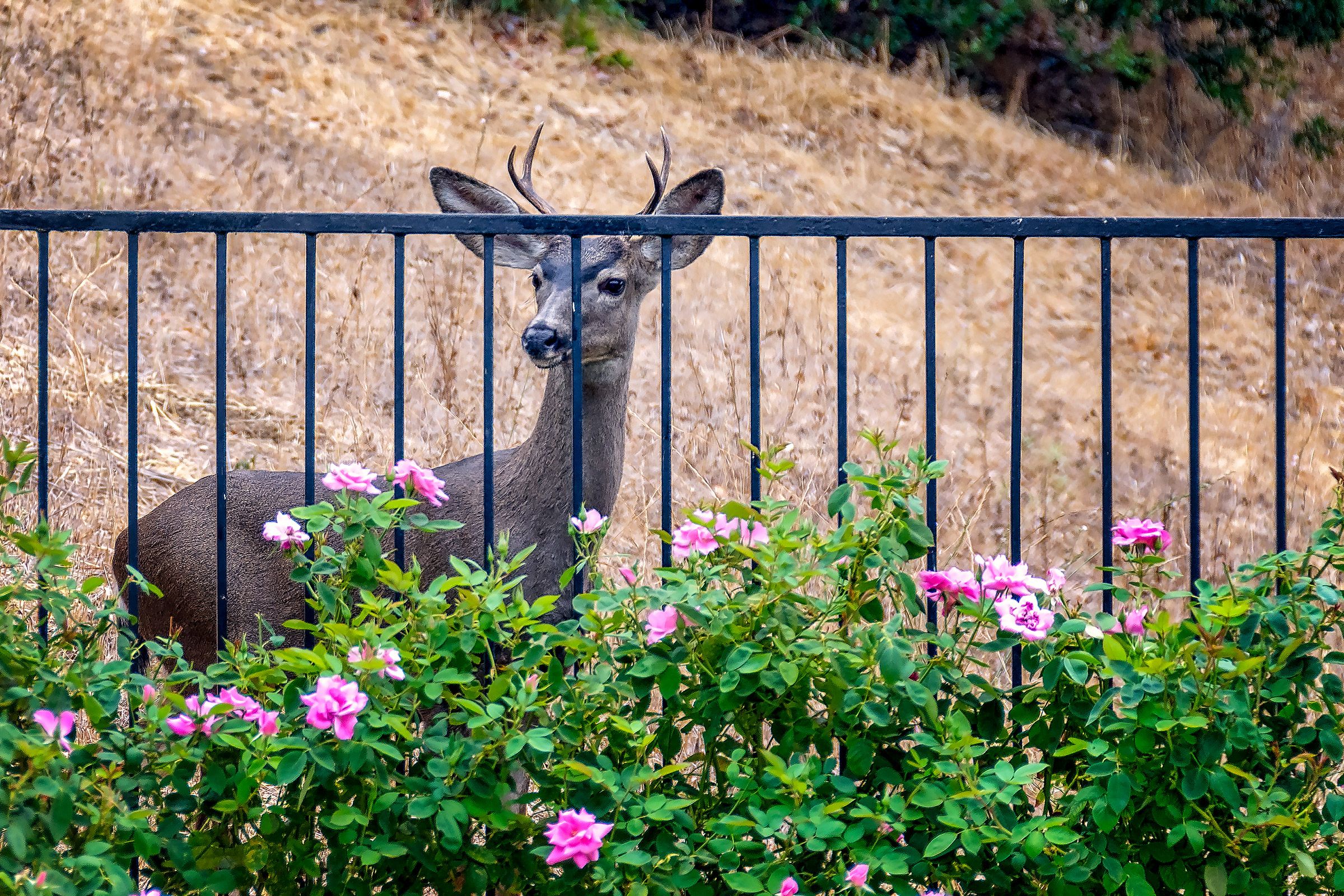We may be compensated if you purchase through links on our website. Our team is committed to delivering honest, objective, and independent reviews on home products and services.
Deer are beautiful and integral parts of their natural ecosystem, but they can wreak havoc on your carefully tended garden. These graceful creatures have a strong appetite for many common plants, leaving behind damaged foliage and disappointed gardeners. Fortunately, there are many strategies you can use to protect your landscaping from deer damage. Our comprehensive guide walks you through 20 effective methods to keep deer away from your yard and garden.
Our suggestions range from deer-proof plants and home remedies to organic solutions and humane exclusion techniques. Our guide is part of a prevention plan you should put into effect now—even before you’ve spotted the season’s first deer.
1. Avoid planting tempting foods
Deer are the hungriest in the spring when does are nursing their fawns and all deer are trying to regain the weight they lost during winter. Avoid planting large amounts of their favorite foods: high-protein, moisture-rich plants such as English ivy, lettuces, beans, peas, hostas, impatiens, and pansies. Fruit trees are also prime targets for deer. As Rhonda Massingham Hart points out in her book on how to keep deer out of your yard, Deerproofing Your Yard & Garden, “The sweetness and flavor of strawberries and peaches make them as attractive to deer as they are to people.”
Instead, focus on incorporating a variety of plants, including those less appealing to deer, to create a balanced and resilient garden ecosystem.
2. Keep their favorite plants close to the house
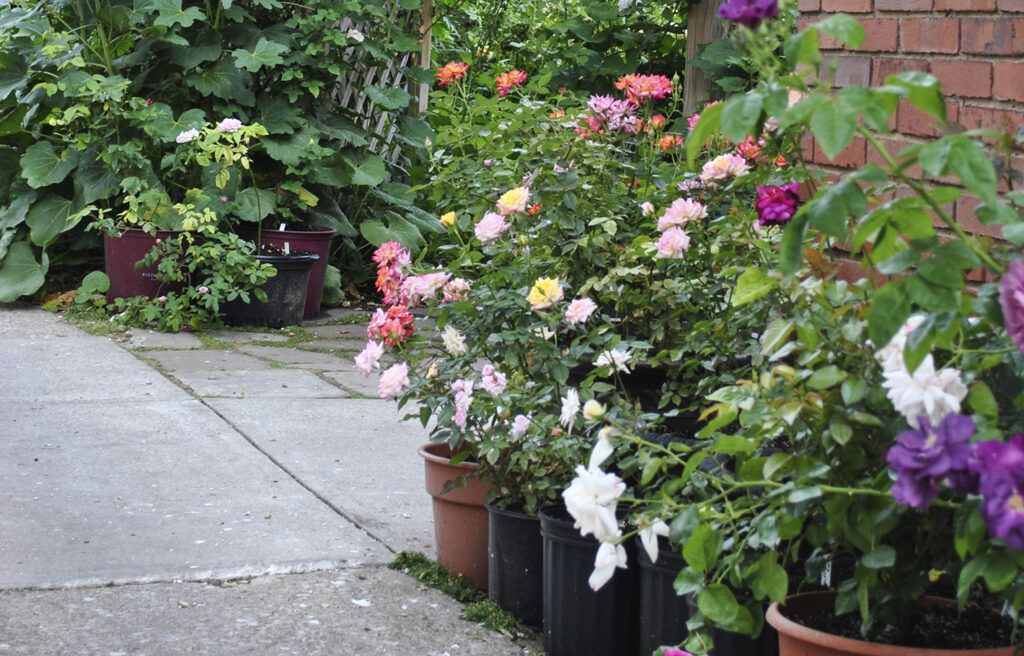
If you keep deer-favored species in your yard, plant them near your home so you can monitor them more closely. Deer tend to prefer smooth, tender, and flavorful plants, including chrysanthemums, clematis, roses, azalea bushes, and various berries. By keeping these plants closer to your living areas, you can spot and deter deer activity more easily before they damage your yard. Additionally, the increased human presence near the home may make deer more hesitant to approach.
3. Plant pungent perennials as a natural barrier
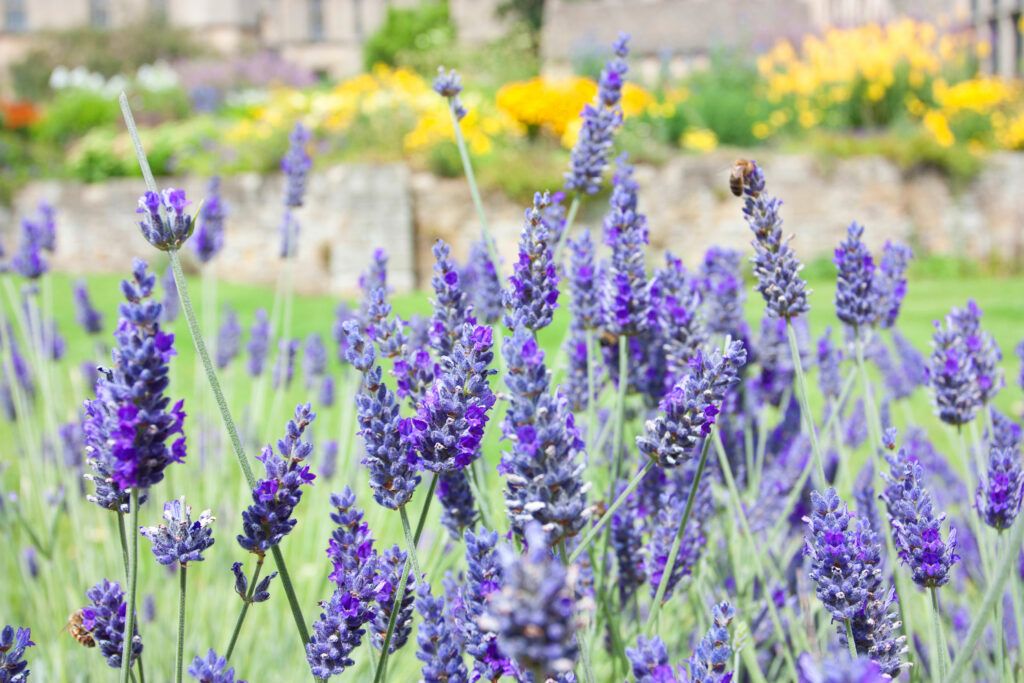
Deer rely heavily on their sense of smell when foraging. Create a perimeter of strongly scented herbs to mask the aroma of your prized plants. Consider planting aromatic varieties such as garlic, chives, mint, and lavender around your garden’s borders or interspersed throughout your landscaping. These pungent plants serve as a natural deer deterrent, provide fresh herbs for cooking, and attract beneficial pollinators. Many of these plants are also relatively low-maintenance, making them highly functional additions to your garden.
4. Plant thorny, hairy, or prickly foliage
While a deer’s sense of smell is its primary guide when selecting food, certain textures can discourage them from eating. Incorporate plants with fuzzy, thorny, or prickly foliage near vulnerable areas and entry points to your garden. Some options include:
- Lamb’s ear (Stachys byzantina)
- Barberry (Berberis species)
- Cleome (Spider flower)
- Globe thistle (Echinops ritro)
- Russian sage (Perovskia atriplicifolia)
These plants deter deer and add interesting textures to your gardenscape, making it more vibrant and dynamic.
5. Make deer-resistant substitutions

When planning your garden, consider substituting deer-favorite plants with similar but less appealing alternatives. Check out reputable sources, such as the Rutgers University list of deer-resistant plants, to find alternatives that match your desired colors, heights, and functions for your garden. Here are some replacement tips:
- Replace tulips with daffodils, which are generally unpalatable to deer
- Choose thorny rose varieties such as Scotch or rugosa roses instead of hybrid tea roses
- Opt for hellebores instead of hostas for shade-loving ground cover
- Plant alliums in place of lilies for spring-blooming bulbs
6. Use trees to hide your garden
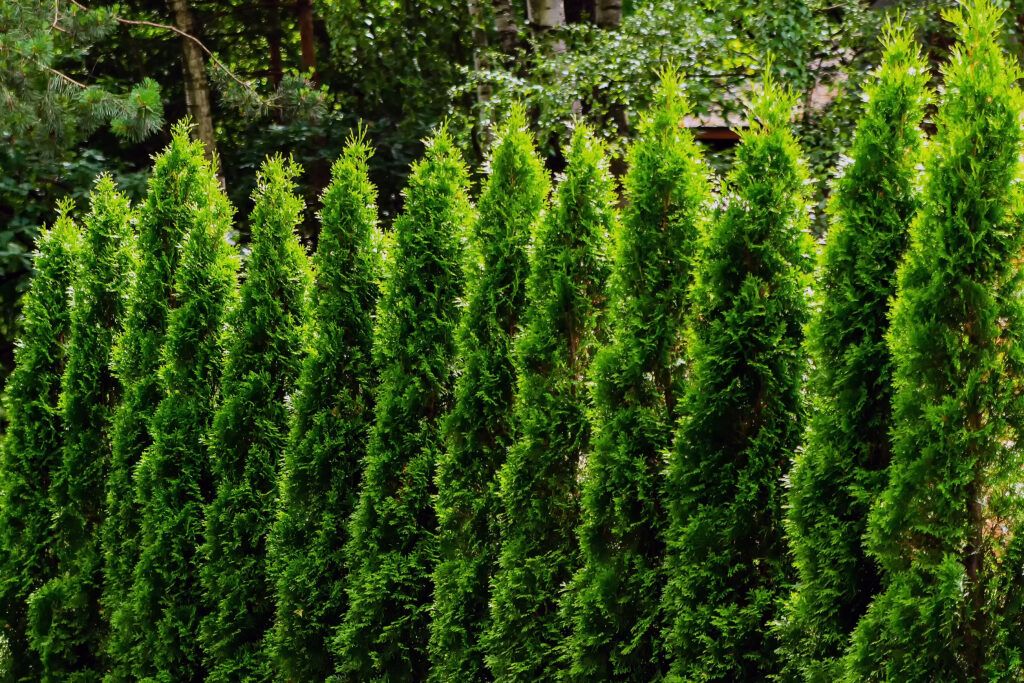
Plant large, sprawling, deer-resistant tree and shrub varieties such as boxwoods, short-needle spruces, or arborvitae around the perimeter of your garden. These plants create visual barriers that can discourage deer from entering your property since they can’t see any food sources. These dense hedges also provide privacy and wind protection for your outdoor spaces. Make sure to regularly prune and take care of your hedges or trees so that they stay strong and effective.
7. Keep it clean
Keep your lawn well-manicured and clear to make your property less inviting to deer. The following practices can keep deer away and keep your garden pest and disease-free:
- Harvest fruits and vegetables immediately once they’re ripe
- Keep compost bins securely covered
- Remove any fallen fruit, yard trimmings, and garden debris promptly
- Store birdseed and pet food indoors or in sealed containers
- Trim tall grasses regularly to discourage deer from hiding or bedding down in your yard
8. Create levels
Deer are not good climbers, so incorporating different levels throughout your property to deter them from coming in. Consider these strategies:
- Add terraces or raised beds to your garden design
- Create sunken gardens surrounded by slightly elevated borders
- Use retaining walls to create distinct levels in sloped yards
- Incorporate steps and multi-level decking in your outdoor living spaces
These design elements discourage deer and add eye-catching dimensions to your landscape. Some of these strategies can also improve drainage and soil conditions.
9. Resort to scare tactics
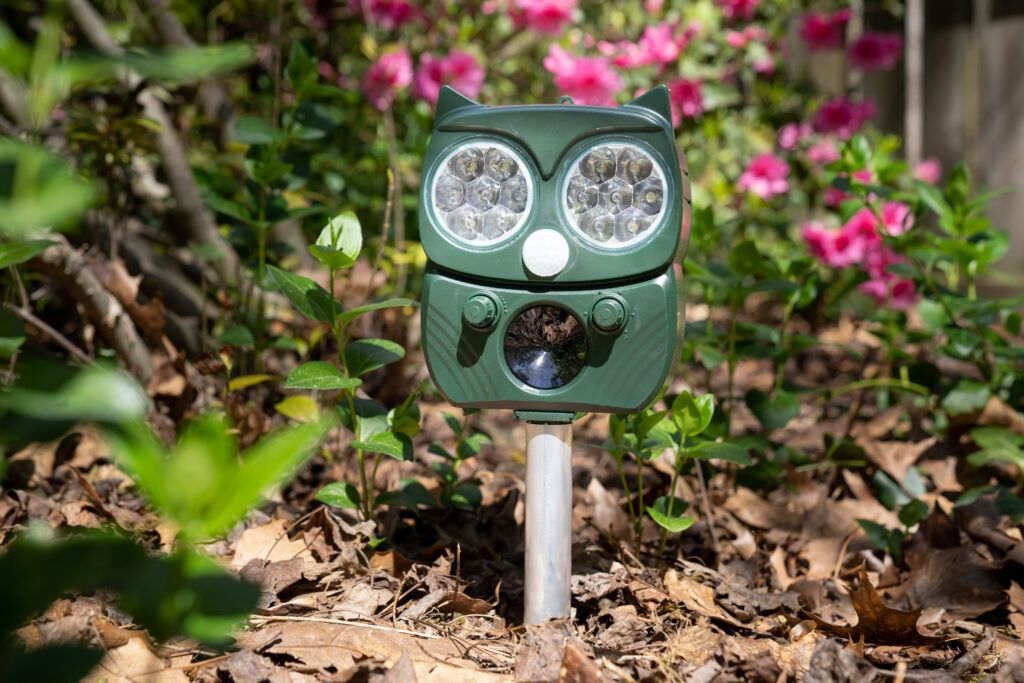
Deer are naturally afraid of new and unfamiliar objects. Take advantage of this by incorporating various scare tactics throughout your garden. Some of these methods may not be the best-looking, but when combined with other strategies, they are incredibly effective for keeping deer on their toes:
- Use reflective tape or old CDs to create flashing light effects
- Hang wind chimes or other noise-making devices
- Install motion-activated sprinklers or lights
- Place scarecrows or other human-like figures in the garden
- Rotate these deterrents regularly to prevent deer from becoming accustomed to them
10. Fence it in
The most effective method for keeping deer off of your property is to install a strong, high fence. For whitetail deer, which are excellent jumpers, here are some fencing guidelines:
- Height: At least 8 feet tall (note that there may be local laws limiting the height of your fence)
- Material: Sturdy wire mesh or wooden slats
- Spacing: No more than 6-inch by 6-inch gaps
- Depth: Bury the fence 6-12 inches deep to prevent deer from pushing underneath
For a more visually subtle alternative, consider installing two parallel fences spaced about 4 feet apart. Deer are less likely to jump when they can’t judge the landing area.
11. Protect new seedlings and plants
Defend vulnerable new plantings and young trees from hungry deer by using physical barriers:
- Cover fruit trees and bushes with netting during the growing season
- Place wire cages around newly planted shrubs and perennials
- Use tree protectors or plastic tree wrap around the trunks of young trees
- Use row covers to protect vegetable gardens
12. Rotate repellents with the seasons
Commercial deer repellants, such as Deer Out Concentrate Deer Repellent and Havahart Weatherproof Deer Repellent, are highly effective, but it’s important to rotate products to prevent deer from becoming accustomed to any single scent or taste. When applying repellents:
- Follow the manufacturer’s instructions carefully
- Reapply after heavy rain or as directed on the product label
- Spray repellents on plants from the ground up to a height of about 6 feet
- Alternate between different types of repellents (e.g., scent-based, taste-based) for maximum effectiveness
13. Use DIY repellants
Many gardeners swear by these inexpensive, homemade deer repellents:
- Create a spray using hot pepper, garlic, and water
- Hang fabric softener strips or bars of strongly scented soap from trees
- Mix rotten eggs with water for a pungent spray
- Place sachets of human hair or blood meal around the garden
- Use ammonia-soaked rags near vulnerable plants
As with commercial repellents, rotate these homemade solutions regularly for the best results. Experiment with different combinations to see which ones work best for your pest control needs. In the video below, This Old House landscape contractor Roger Cook demonstrates how to use some of these methods to deer-proof a homeowner’s shrubs.
14. Avoid toxic products
When selecting or creating deer repellents, always prioritize the safety of your family, pets, and other wildlife. Always choose humanely created formulas and avoid using poisons or toxic substances. Some safe practices include:
- Using food-grade ingredients in homemade solutions
- Keeping repellents out of reach of children and pets
- Opting for organic or natural commercial repellents
- Following all safety guidelines provided with commercial products
- Washing fruits and vegetables thoroughly before consumption
15. Fishing line as an invisible barrier
Monofilament fishing line can be used as a nearly invisible barrier that confuses deer, causing them to avoid the area. This method can be particularly useful for protecting specific high-value plants or smaller garden areas.
- Install stakes or posts around the perimeter of the area you want to protect
- String the fishing line between the stakes at a height of 2-3 feet
- Use multiple strands for increased effectiveness
- Check and replace the line periodically as needed
16. Let the dogs out

Dogs are not only great friends, but they are also effective, non-intrusive deer repellents. Their scents and barking naturally repel deer from your property. For the best results:
- Allow your dog to spend time in the yard, especially during dawn and dusk when deer are most active
- Use dog hair in your garden as an additional scent deterrent
- Consider installing a dog door for easy access to the yard
- If you don’t have a dog, ask neighbors if they’d be willing to let their dogs visit your yard occasionally
- Be sure to monitor your pet while they’re outside to reduce harm to wildlife
17. Motion-activated sprinklers
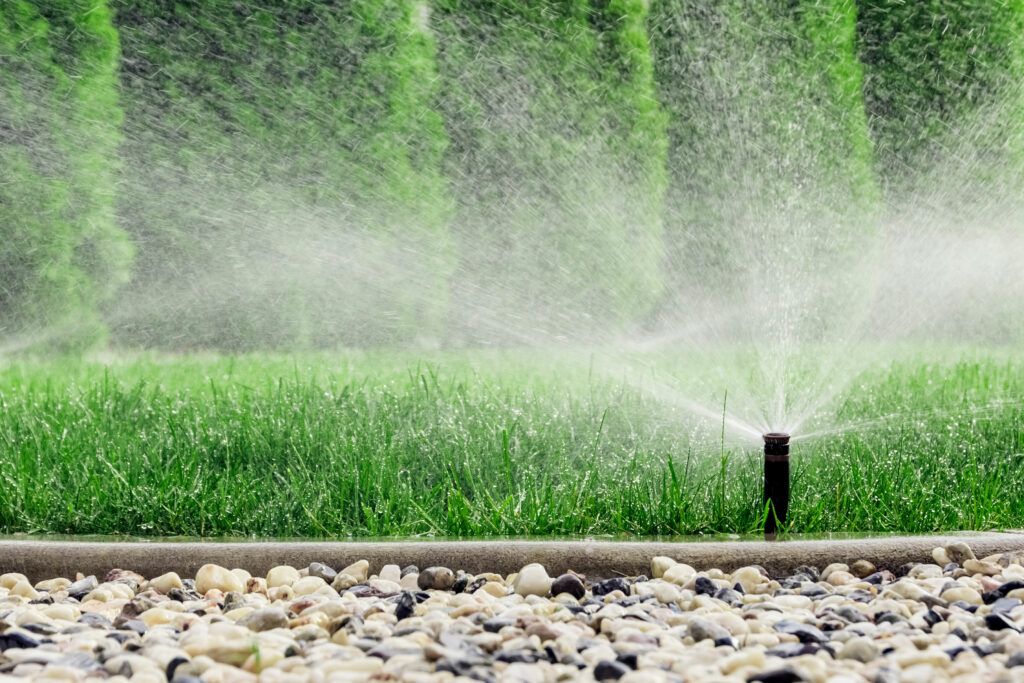
Motion-activated sprinklers can startle deer and discourage them from entering your garden. They can also keep your garden watered and reduce the need for manual watering or sprinkler control. Here are some tips for strategically placing these sprinklers for the best result:
- Place sprinklers at key entry points around your property
- Adjust the sensitivity to avoid false triggers from smaller animals
- Move the sprinklers periodically to prevent deer from learning their locations
- Consider using solar-powered models to reduce energy costs
- Combine with other deterrent methods for maximum effectiveness
18. Light it up

Deer prefer to feed at night, so make feeding in your yard as uncomfortable for them as possible. While they may eventually realize the lights are harmless, the initial shock can be an effective deterrent when combined with other methods, and can also make your garden safer to work in at night :
- Install motion-activated floodlights around your property
- Use solar-powered garden lights to illuminate pathways and borders
- Consider timer-controlled lights that activate during peak deer feeding times
- Combine lighting with reflective materials for added effect
- Rotate or reposition lights periodically to prevent habituation
19. Make some noise
Deer are easily startled by sudden or unfamiliar noises. Combine sound with other methods for a slightly rowdy but effective way to keep them from your yard:
- Set up a radio tuned to a talk station or static
- Create a DIY noise maker using tin cans or aluminum pie plates
- Use wind chimes or other noise-making garden ornaments
- Install ultrasonic deer-repellent devices
- Vary the type and location of noise deterrents to prevent habituation
Remember to be considerate of your neighbors when using noise-based deterrents, especially at night.
20. Get creative
No single deer deterrent method is foolproof. Deer are adaptable and can get used to certain strategies, so use a dynamic approach to reduce damage to your garden without harming local wildlife.
- Combine multiple deterrent methods
- Rotate and vary your approaches regularly
- Be persistent and patient in your efforts
- Monitor your garden for signs of deer activity and adjust your strategy accordingly
- Consider the specific deer population and behavior in your area
If you find that DIY methods are not effective and you’re looking for professional pest control, here are a few comprehensive resources:
